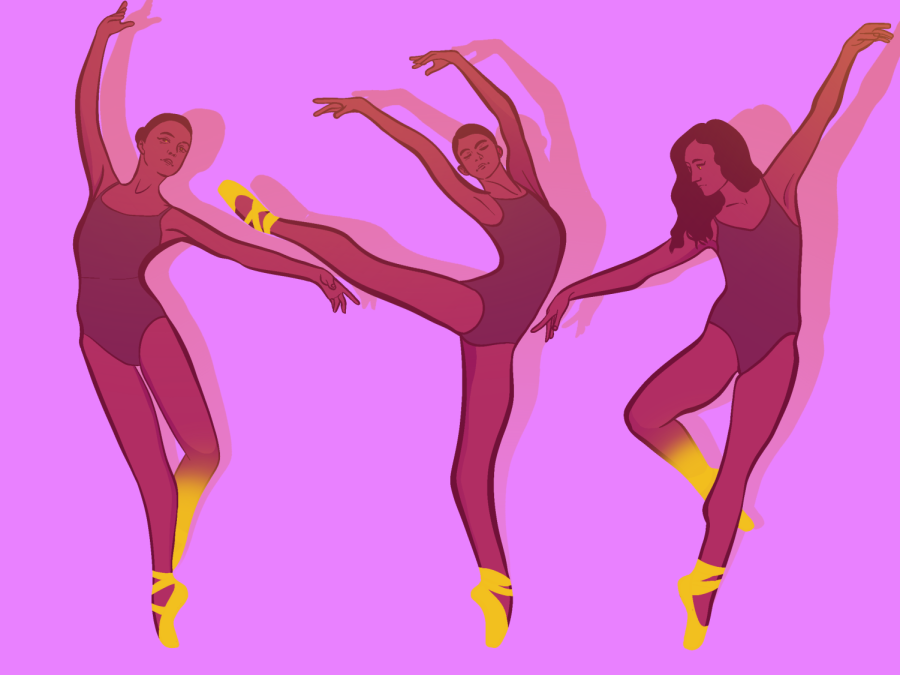A deeper look at the athletic art: Ballet
Ballet, an art most recognized for the beauty and poise of its dancers. These athletes dedicate themselves to visual storytelling, with complex music and costumes. Beneath the beautiful exterior lies a complex history, one of dedication and intensity.
May 15, 2023
A tutu bounces in the blinding light, the red drapes of the curtain sit lazily on the side and a dazzling set sits as a ballerina jumps and turns across the stage to beautiful classical music: this is a ballet performance. Beyond the curtain, however, contains grueling training, long hours in the studio at a time, aching bodies, blistered toes, shin splints and much more to make an incredible performance. Ballet has been a constantly overlooked activity for its skill, dedication and focus. Many underestimate the stamina and strength with its advanced steps and physical rigor.
Where did Ballet originate from?
Ballet originated from Italy during the Italian Renaissance in the 1500s. Ballet comes from the Italian word “ballare” which means “to dance.” It was originally introduced by Catherine de Medici of Italy when she married the French King Henry ll, bringing ballet to France.
The costumes first began with dancers dressed in brocading outfits that looked nice on the body but only enabled dancers to do small turns and little steps. Ballet continued to prosper for the next 100 years in France, soon making the terminology and vocabulary of Ballet French during the reign of King Louis XIV when he ordered the founding of Academie Royale de Danse.

Soon ballet expanded to places such as Russia, a leading country of dance creativity in the 1850s. Ballet soon began to evolve as we know it today in the early nineteenth century. Dancers began to wear white short bell-like skirts and began dancing on en pointe (on toe), created by Charles Didelot in 1796 calling them his “flying machine” as they lifted dancers upwards. Unfortunately pointe was reserved for women only, but now, the ballet norms are being changed to welcome all, taking a step towards respect for all in the dance industry.
Ballet continued to prosper in the twentieth century when the Russian theater producer, Serge Diaghilev, brought together the country’s most talented choreographers and dancers to form a group called the Ballet Russes. The Ballet Russes toured the world and expanded ballet to the fullest.
Ballet in America
Ballet began to take form in the United States in the 1930s when some of Diaghilev’s dancers went to dance and live there and ballet is now growing throughout the U.S. George Balanchine is very well known for establishing ballets in the U.S. by founding the famous New York City Ballet and creating many famous ballets performed today by companies.
Necessary strength
Today, ballet is admired for its beauty and grace, with many people attending ballet performances such as the Nutcracker and Swan Lake. But why is this dance of beauty so difficult to learn?
The most impressive aspect of ballet to viewers is en pointe. It constantly amazes watchers because dancers are able to do the thought impossible by standing, turning and doing tricks on their toes. This is one of the most difficult things for a ballet dancer to learn.
Dancers do not start on en pointe right away. Depending on the amount of training time, most go on pointe when they are about 11 to 13 years old, if their trainer feels they are ready. This shows that it takes years of training to have the strength to even get to wear pointe shoes. When the dancer goes on pointe, there are also weeks and months of training before they can do the real moves and have the strength in their ankles.
Not only do dancers show strength in their toes but also their ankles to support their weight when on pointe. If dancers have weak ankles they are at risk of a spraining or even breaking the bone. In a study by pubmed.gov, 53% of ballet injuries occur in the foot or ankle. Pointe also brings bruised or broken toe nails, blisters and calluses, stress fractures and other longer term injuries.
Although ballet looks relatively easy, that’s exactly how the dancers are trying to fool you. As difficult as ballet is, dancers still are able to keep stamina and look graceful when doing difficult moves. The execution of ballet is to make it look effortless.
Dancers making a difference
One ballerina who led the way for equality in dance was Misty Copeland. Copeland was the first African American ballet dancer to be promoted to principal dancer at the American Ballet Theater (ABT) in New York. Starting dance at the late age of 13, Copeland is viewed as a prodigy as after only two years of dancing, was already receiving offers from professional companies and won the Los Angeles Music Center Spotlight Award.
Copeland was then part of ABT´s company in 2000, in the corps in 2001, a soloist in 2007 and then promoted to principal dancer in 2015. Copeland is also a public speaker, stage performer and has written multiple books and autobiographies. On Copeland’s famous Under Armour pictures and video ad, she also revealed how much strength is necessary for a dancer and showed that they are not just dainty and thin but have defined muscles and are built athletes.
The difficulties of ballet
As difficult as ballet is, it can still be very enjoyable for people and allows for the dancer to be challenged physically and mentally. It is also great exercise because it requires strength all over the body. Ballerinas need to have strength in their ankles, arms, back, legs, abs, upper body and many more important body parts to be successful in dancing. You’re probably wondering, what is the most difficult move in ballet?
Every move in ballet has some sort of challenging aspect. When performing, ballerinas will complete all sorts of difficult jumps and turns and even the simplest of moves is difficult. One extremely difficult move is the fouette turn, meaning “a quick whipping movement.” This requires a dancer to turn consecutively by putting their leg out in front and whipping it around in a passe position.
Other difficult moves are consecutive turns which can include chaine turns, pirouettes, step-over turns and piques. Many types of jumps are difficult, especially when dancers are required to do many in a row. There is also partner dancing where one dancer must use strength to lift another dancer up, down and around while the lifted dancer must hold their positions. The other dancer also has to be able to hold their positions and work together with the liftingdancer.
Ballet requires focus, stamina, dedication and strength and is a dance that should be acknowledged and appreciated. There are even some local ballet performances occurring here in Ventura that Foothill tech students should check out including Snow White, performed by Footworks Youth Ballet.















